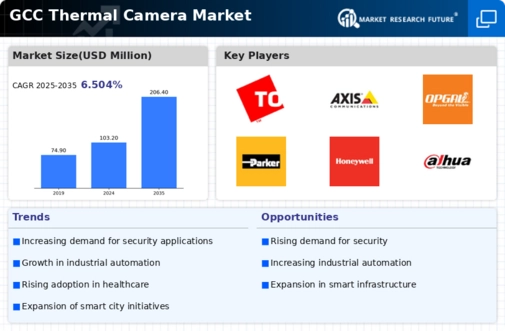Growing Demand in Healthcare Sector
The healthcare sector in the GCC is increasingly recognizing the value of thermal cameras for non-invasive diagnostics and patient monitoring. Thermal imaging technology is being utilized for detecting fevers, monitoring blood flow, and assessing inflammation, among other applications. The rising prevalence of chronic diseases and the need for efficient diagnostic tools are propelling the demand for thermal cameras in healthcare settings. Market analysis suggests that the healthcare segment could account for approximately 25% of the thermal camera market by 2026. This growing demand is indicative of the broader trend towards adopting advanced imaging technologies in medical practices, thereby fostering growth in the thermal camera market.
Rising Awareness of Energy Efficiency
The thermal camera market is benefiting from a growing awareness of energy efficiency among businesses and consumers in the GCC. As energy costs continue to rise, organizations are increasingly seeking solutions to identify energy losses and optimize consumption. Thermal cameras play a crucial role in detecting heat leaks in buildings and industrial facilities, which can lead to substantial cost savings. Reports indicate that businesses utilizing thermal imaging for energy audits can achieve energy savings of up to 30%. This heightened focus on sustainability and energy conservation is likely to drive demand for thermal cameras, thereby positively impacting the thermal camera market.
Government Initiatives and Regulations
Government initiatives aimed at enhancing safety and security standards are significantly influencing the thermal camera market in the GCC. Regulatory bodies are mandating the use of thermal imaging technology in various sectors, including healthcare, construction, and public safety. For example, the introduction of safety regulations requiring thermal inspections in construction projects has led to a projected market growth of 15% in this segment. Additionally, government investments in smart city projects are further driving the adoption of thermal cameras for surveillance and monitoring purposes. These initiatives not only promote the use of advanced technology but also create a conducive environment for the thermal camera market to thrive.
Increasing Adoption in Industrial Applications
The thermal camera market is experiencing a notable surge in adoption within industrial sectors across the GCC. Industries such as oil and gas, manufacturing, and construction are increasingly utilizing thermal cameras for predictive maintenance, quality control, and safety inspections. This trend is driven by the need for enhanced operational efficiency and reduced downtime. For instance, the oil and gas sector has reported a 20% reduction in equipment failure rates through the implementation of thermal imaging technology. As industries seek to optimize processes and ensure compliance with safety regulations, the demand for thermal cameras is expected to grow, thereby propelling the thermal camera market forward.
Technological Advancements in Imaging Technology
Technological advancements in imaging technology are reshaping the thermal camera market in the GCC. Innovations such as higher resolution sensors, improved image processing algorithms, and integration with artificial intelligence are enhancing the capabilities of thermal cameras. These advancements enable users to obtain more accurate and detailed thermal images, which are essential for various applications, including building inspections and electrical maintenance. The introduction of compact and portable thermal cameras has also expanded their usability in the field. As technology continues to evolve, the thermal camera market is expected to witness increased adoption across diverse sectors, driven by the demand for more sophisticated imaging solutions.





















Leave a Comment